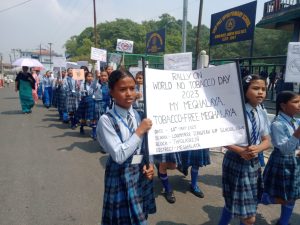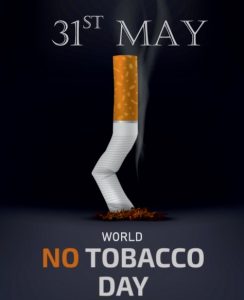 Amid surging numbers of tobacco related health concerns, Arindam Biswas and Dr. Firdaus Samad call attention to the direct impact of tobacco usage and oral health in Meghalaya ahead of World No Tobacco Day.
Amid surging numbers of tobacco related health concerns, Arindam Biswas and Dr. Firdaus Samad call attention to the direct impact of tobacco usage and oral health in Meghalaya ahead of World No Tobacco Day.
In 2023, Meghalaya was recognised by the World Health Organisation for its tobacco control efforts, as reported by HP News on May 27, 2023. Despite this accolade, the state continues to grapple with one of the highest tobacco use rates in the country. According to the Global Adult Tobacco Survey (GATS) 2016-17, 47.5% of adults over 15 years in Meghalaya consume tobacco in some form. That is significantly higher than the national average of 28.6%. While the detrimental effects of tobacco on physical and oral health are well-documented, the exacerbating role of under-nutrition has not been sufficiently highlighted. Undernutrition, a form of malnutrition, significantly increases the risk of developing oral cancers and other oral health issues among tobacco users. Scientific studies have shown that undernourished individuals who consume tobacco are at a much higher risk of suffering from a double burden of diseases, making them vulnerable to a wide range of health problems. This underscores the need for continued and enhanced efforts in both tobacco control and nutritional interventions to mitigate these compounded health risks.
Increasing concern on Oral health
 Tobacco use has numerous adverse effects on oral health. It can cause tooth discolouration, leading to yellow or brown stains due to nicotine and tar content. Smokers are at a significantly higher risk of developing gum disease, as tobacco chemicals irritate the gums, causing inflammation, infection, gum recession, and potential tooth and bone damage. Bad breath is common among smokers due to the combination of tobacco smoke and bacterial build-up in the mouth. More severe problems include precancerous conditions and an increased risk of oral cancer. Tobacco is consumed in both smoke and smokeless forms. Smokeless forms include gutkha, khaini, and zarda, while the smoke forms mainly include cigarettes and bidis where 23.4% of adults smoke cigarettes and 12.6% smoke bidi. According to the GATS 2 (2016-2017) study, 53.7% of men and 9.5% of women in Meghalaya smoke tobacco, and 11.6% of men and 29.1% of women use smokeless tobacco. Smokeless tobacco (SLT) usage alters taste buds, increases the chances of developing gall bladder stones and during pregnancy, leads to anemia, low birth weight babies, and pregnancy-related complications. Several reports mentioned that in Meghalaya, 12.6% of adolescents aged 15-17 years consume tobacco. This widespread usage can be attributed to peer influence, ease of accessibility, and the relatively low cost of tobacco products.
Tobacco use has numerous adverse effects on oral health. It can cause tooth discolouration, leading to yellow or brown stains due to nicotine and tar content. Smokers are at a significantly higher risk of developing gum disease, as tobacco chemicals irritate the gums, causing inflammation, infection, gum recession, and potential tooth and bone damage. Bad breath is common among smokers due to the combination of tobacco smoke and bacterial build-up in the mouth. More severe problems include precancerous conditions and an increased risk of oral cancer. Tobacco is consumed in both smoke and smokeless forms. Smokeless forms include gutkha, khaini, and zarda, while the smoke forms mainly include cigarettes and bidis where 23.4% of adults smoke cigarettes and 12.6% smoke bidi. According to the GATS 2 (2016-2017) study, 53.7% of men and 9.5% of women in Meghalaya smoke tobacco, and 11.6% of men and 29.1% of women use smokeless tobacco. Smokeless tobacco (SLT) usage alters taste buds, increases the chances of developing gall bladder stones and during pregnancy, leads to anemia, low birth weight babies, and pregnancy-related complications. Several reports mentioned that in Meghalaya, 12.6% of adolescents aged 15-17 years consume tobacco. This widespread usage can be attributed to peer influence, ease of accessibility, and the relatively low cost of tobacco products.
 Consuming tobacco significantly increases the risk of developing oral cancers, especially in undernourished individuals. Undernutrition, characterised by insufficient intake of energy and essential nutrients, can manifest as protein-energy wasting or micronutrient deficiencies, such as vitamins, iron, and zinc. These deficiencies adversely affect physical and mental functioning. Iron deficiency anemia is the most common form of anemia and is on the rise in Meghalaya. According to the National Family Health Survey 5 (NFHS-5), 59.1% of women aged 15 to 49 years and 25% of men in the same age group are anaemic. This represents an increase of 9% in women and 10% in men compared to the NFHS-4 survey.
Consuming tobacco significantly increases the risk of developing oral cancers, especially in undernourished individuals. Undernutrition, characterised by insufficient intake of energy and essential nutrients, can manifest as protein-energy wasting or micronutrient deficiencies, such as vitamins, iron, and zinc. These deficiencies adversely affect physical and mental functioning. Iron deficiency anemia is the most common form of anemia and is on the rise in Meghalaya. According to the National Family Health Survey 5 (NFHS-5), 59.1% of women aged 15 to 49 years and 25% of men in the same age group are anaemic. This represents an increase of 9% in women and 10% in men compared to the NFHS-4 survey.
 Undernourished individuals have a weak immune system that’s incapable of fighting infections and diseases, including cancer. Tobacco generates free radicals which are highly reactive in nature and are known to be linked to the development of cancers. That makes it easier for the cancerous cells to develop and proliferate. Tobacco use induces chronic inflammation and oxidative stress which are key mechanisms in the development of cancers. Undernourished individuals who already have weak antioxidant defences are less able to counter these harmful effects increasing their chances of developing oral cancer. Undernutrition also causes micronutrient deficiencies leading to low levels of vitamin A, B 12, C, and E, iron and Zinc, which can have significant detrimental effects on an individual’s oral health which is further enhanced by tobacco use. It can cause gum-related problems such as inflammation, bleeding gums, and
Undernourished individuals have a weak immune system that’s incapable of fighting infections and diseases, including cancer. Tobacco generates free radicals which are highly reactive in nature and are known to be linked to the development of cancers. That makes it easier for the cancerous cells to develop and proliferate. Tobacco use induces chronic inflammation and oxidative stress which are key mechanisms in the development of cancers. Undernourished individuals who already have weak antioxidant defences are less able to counter these harmful effects increasing their chances of developing oral cancer. Undernutrition also causes micronutrient deficiencies leading to low levels of vitamin A, B 12, C, and E, iron and Zinc, which can have significant detrimental effects on an individual’s oral health which is further enhanced by tobacco use. It can cause gum-related problems such as inflammation, bleeding gums, and  periodontitis, with iron deficiency specifically leading to swollen inflamed tongue and swallowing difficulties. Cracks in the corners of the mouth (angular cheilitis) are common in those with vitamin B12 deficiency anemia. While these problems are reversible with treatment, undernutrition has been identified as a risk factor for the development of oral cancer as well as precancerous conditions like leukoplakia, oral submucous fibrosis, and oral lichen planus. Undernutrition is a cyclical problem where poor nourishment leads to poor oral health, which in turn affects nutritional uptake, further diminishing the individual’s ability to combat oral cancers.
periodontitis, with iron deficiency specifically leading to swollen inflamed tongue and swallowing difficulties. Cracks in the corners of the mouth (angular cheilitis) are common in those with vitamin B12 deficiency anemia. While these problems are reversible with treatment, undernutrition has been identified as a risk factor for the development of oral cancer as well as precancerous conditions like leukoplakia, oral submucous fibrosis, and oral lichen planus. Undernutrition is a cyclical problem where poor nourishment leads to poor oral health, which in turn affects nutritional uptake, further diminishing the individual’s ability to combat oral cancers.
Meghalaya, referred to as the ‘Cancer Capital’ of India by a Times of India article dated June 1, 2022, exhibits high prevalence rates of esophageal, throat, nose, and lung cancers. According to a 2021 report by the National Centre for Disease Informatics and Research, esophageal cancer affects 31% of males and 22.3% of females in the state. Additionally, a World Health Organisation report dated February 9, 2021, stated that tobacco-related diseases result in approximately 8,000 deaths annually in Meghalaya.
What can be done?
 To effectively tackle undernutrition and high tobacco consumption in Meghalaya, a multifaceted approach is crucial. Currently, the government has mandated all educational institutions to be declared ‘Tobacco-Free,’ banning the sale of tobacco within 100 meters of these institutions and banning sale to those below 18. Additionally, students in Meghalaya regularly participate in rallies like “My Meghalaya, Tobacco-Free Meghalaya” to raise awareness about the harmful effects of tobacco consumption. Educational institutions also display posters and conduct webinars to generate awareness about the dangers of tobacco use. These efforts indicate significant progress in combating tobacco use among youth through various programs and initiatives. To further enhance these efforts, deepening community engagement through anti-tobacco campaigns and initiatives can mobilise collective action against tobacco use and foster a supportive environment for quitting. Targeted interventions in high-risk groups, such as adolescents, can address the problem and tackle contributing factors to tobacco consumption. Addressing undernutrition should include not only education and awareness programs on nutrition and balanced diets but also initiatives to make nutritious food accessible, especially to the younger generation. School gardens can enhance dietary diversity and combat hidden hunger. Strengthening health and nutrition services by providing micronutrient supplements, regular health check-ups, and monitoring nutritional status is essential for the early detection and intervention of complications related to oral health. Lastly, strengthening the enforcement of current laws and policies, such as the Cigarettes and Other Tobacco Products Act (COTPA) and the Weekly Iron and Folic Acid Supplementation (WIFS) program, can significantly improve the current situation..
To effectively tackle undernutrition and high tobacco consumption in Meghalaya, a multifaceted approach is crucial. Currently, the government has mandated all educational institutions to be declared ‘Tobacco-Free,’ banning the sale of tobacco within 100 meters of these institutions and banning sale to those below 18. Additionally, students in Meghalaya regularly participate in rallies like “My Meghalaya, Tobacco-Free Meghalaya” to raise awareness about the harmful effects of tobacco consumption. Educational institutions also display posters and conduct webinars to generate awareness about the dangers of tobacco use. These efforts indicate significant progress in combating tobacco use among youth through various programs and initiatives. To further enhance these efforts, deepening community engagement through anti-tobacco campaigns and initiatives can mobilise collective action against tobacco use and foster a supportive environment for quitting. Targeted interventions in high-risk groups, such as adolescents, can address the problem and tackle contributing factors to tobacco consumption. Addressing undernutrition should include not only education and awareness programs on nutrition and balanced diets but also initiatives to make nutritious food accessible, especially to the younger generation. School gardens can enhance dietary diversity and combat hidden hunger. Strengthening health and nutrition services by providing micronutrient supplements, regular health check-ups, and monitoring nutritional status is essential for the early detection and intervention of complications related to oral health. Lastly, strengthening the enforcement of current laws and policies, such as the Cigarettes and Other Tobacco Products Act (COTPA) and the Weekly Iron and Folic Acid Supplementation (WIFS) program, can significantly improve the current situation..
The additive effect of undernutrition and tobacco consumption on oral health indicates that a more robust and comprehensive awareness promotion program is needed to fight oral cancer and other oral cavity related diseases. The synergistic relationship between malnutrition and tobacco consumption, particularly in the context of oral health and the enhanced risk of oral cancer, presents a critical public health concern that demands immediate attention. Addressing these intertwined risk factors is imperative for healthcare authorities to develop targeted interventions and policies aimed at reducing the burden of this devastating disease to build a healthier Meghalaya.
(The authors are students of Master of Public Health Students at the Indian Institute Of Public Health, Shillong)



